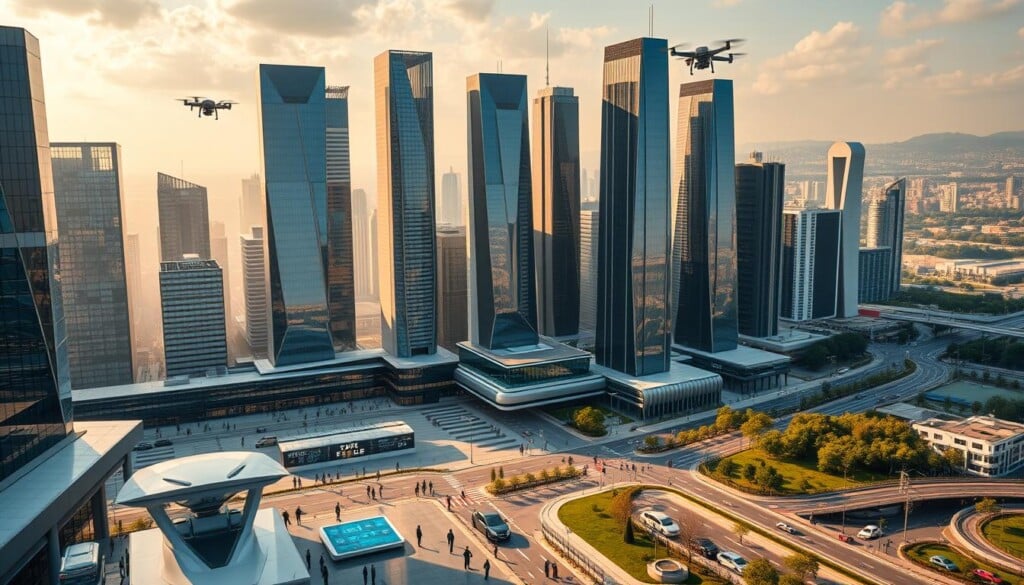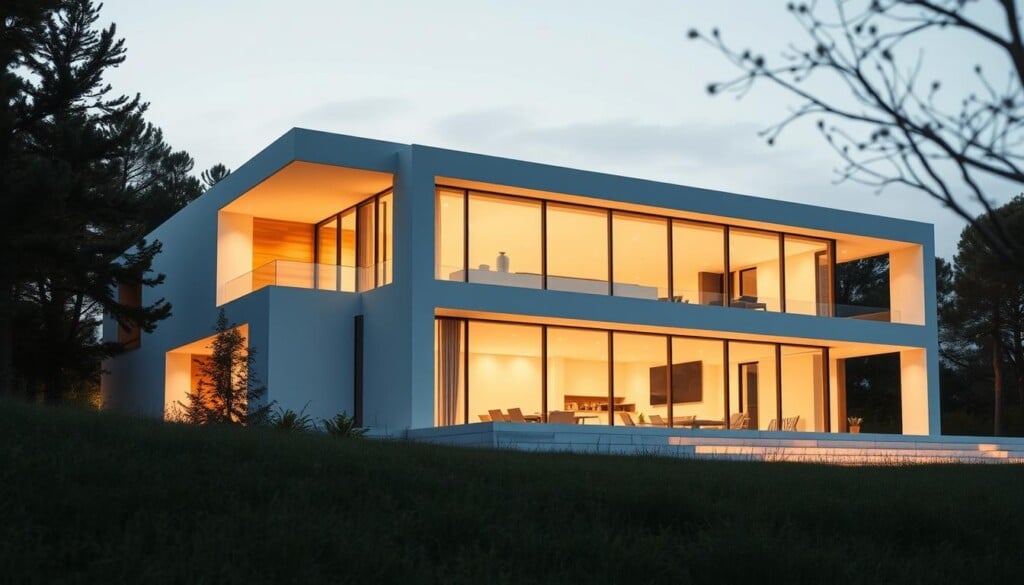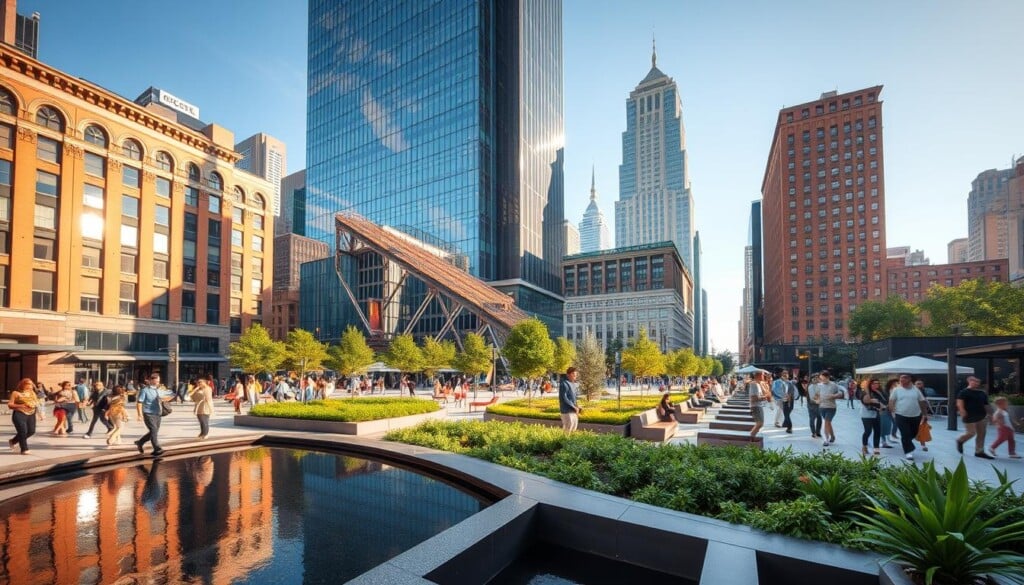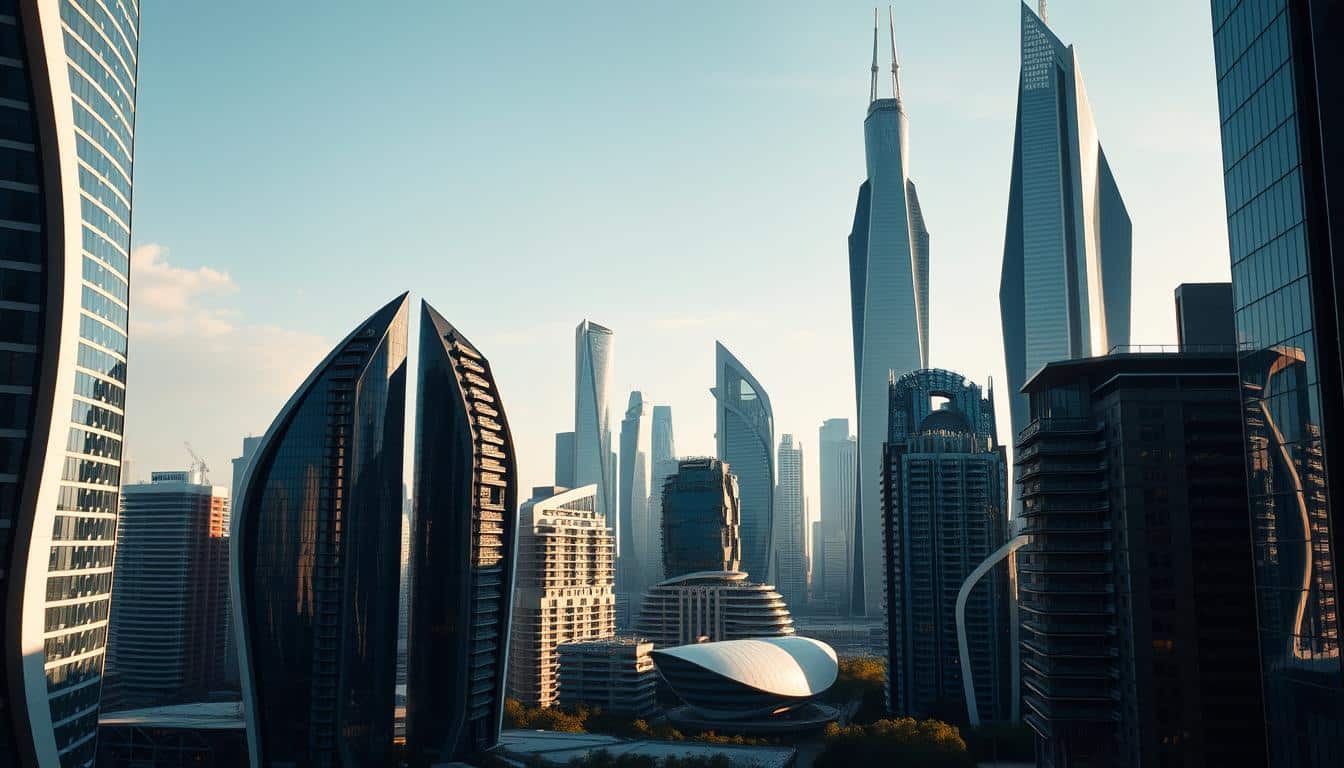Is the USA really embracing new architecture trends? 2023 is a big year for sustainable design and urban planning. Architects and developers are changing how we build.
This article looks at trends that tackle today’s big challenges. These ideas make our spaces better for living and kinder to the planet. We’ll see how tech, community, and mental health shape the future of buildings.
Key Takeaways
- Innovative trends in architecture focus on sustainability and environmental impact.
- There is a growing emphasis on community engagement in architectural design.
- Technological integration plays a critical role in modern building practices.
- Mental health considerations are increasingly being incorporated into design.
- Urban planning is adapting to meet the needs of evolving communities.
Emphasis on Sustainable Design
Sustainability in architecture is becoming a key principle, moving from a preference to a must-have in modern design. It makes buildings more efficient and eco-friendly. Using green materials, architects cut down on waste and improve indoor air quality.
Green Building Materials
Materials like bamboo, recycled steel, and reclaimed wood are now the norm. They help reduce waste and lower carbon emissions. Architects choose these to create buildings that are good for the planet.
Using these materials shows a dedication to protecting the environment. It also raises awareness about saving resources.
Energy Efficiency Techniques
Energy-saving methods are vital in sustainable design. Techniques like advanced insulation and solar panels improve a building’s energy use. These solutions help save resources and make buildings more comfortable.
The push for energy efficiency is part of a larger effort. It aims to make architecture more eco-friendly and tackle climate change challenges.
The Rise of Smart Buildings
Smart buildings are becoming more common, showing a big change in architecture. They use the Internet of Things (IoT) to make buildings better and more comfortable. These buildings have advanced sensors and systems that control things like lighting, temperature, and energy use.
This change is not just for big buildings. Smart homes are also getting a lot of benefits from these new technologies.
Integration of IoT in Architecture
IoT technology is changing the way buildings are made. Architects are now adding devices that can talk to each other. This makes buildings smarter, adjusting to what people need in real time.
This smart approach makes buildings more efficient and comfortable. It also helps buildings be more sustainable, which is good for the environment.
Benefits of Smart Technology in Homes
Smart technology in homes has many benefits. It helps save energy by using it only when needed. It also makes homes safer with features like cameras and alarms.
Smart homes can even change to fit what you like, making your life better. The growth of smart buildings is key to solving city problems and improving life for everyone.

Adaptive Reuse in Urban Planning
Adaptive reuse is a smart way to update old buildings for today’s needs. It turns old structures into useful spaces. This method helps save space and keeps history alive.
By changing the use of buildings, cities can keep their unique look. They can add new designs while keeping the old charm.
Transforming Old Structures
Adaptive reuse makes old landmarks or unused places useful again. Like turning old warehouses into lively spots for living and work. This way, cities use less new materials and help the environment.
It’s all about keeping the old beauty and adding new touches. This shows how adaptive reuse works well.
Successful Adaptive Reuse Projects
Many projects show how adaptive reuse can make cities better. Old factories now house trendy apartments. This brings life and keeps history alive.
These changes attract people and businesses. They make neighborhoods more lively and connected.
Biophilic Design Principles
Biophilic design focuses on the bond between humans and nature. It makes spaces that connect us with the outdoors, boosting our well-being. By adding greenery, sunlight, and water, architects help create healthier, lively places.
Incorporating Nature in Architecture
Biophilic design changes how we build. It uses materials that look like nature. This includes living walls and rooftop gardens, blending indoors with outdoors.
These features make spaces look good and feel connected to nature. They help us feel grounded and at peace.
Health Benefits of Biophilic Spaces
Studies show biophilic spaces are good for our health. They lower stress and improve mood and work performance. Being near nature boosts our brain power and reduces worry.
Biophilic design in buildings is all about well-being. It makes spaces that are not just pretty but also good for us.
Modular and Prefab Construction
Modular construction and prefab buildings are becoming more popular in the construction world. They use off-site manufacturing to make building faster and more efficient. This helps solve problems like labor shortages and high material costs.
Speed and Efficiency in Building
Modular building projects are much quicker than traditional ones. This is because parts are made in a controlled place and then put together fast. It’s great for developers who need to finish projects quickly without sacrificing quality.
Cost-Effectiveness of Modular Design
Prefab buildings are also cheaper to make, making them a smart choice for spending. They save on labor costs and reduce waste. This means you can get high-quality buildings without spending too much, making them popular everywhere.
Minimalist Architecture Aesthetics
Today, minimalist architecture is all the rage. It focuses on simplicity and function. This style keeps things clean and simple, removing anything not needed.
As cities grow, people want calm and tidy spaces. Minimalist design offers just that.
Embracing Simplicity in Design
Minimalist architecture is all about simplicity. It creates peaceful places. Using natural materials helps connect us to nature.
This approach also lets in lots of natural light. It balances beauty with usefulness, fitting today’s trends.
Popular Minimalist Projects
Many projects show off minimalist architecture’s charm. The Farnsworth House and the Kvarnby House are great examples. They blend with nature and look modern.
These designs inspire others to focus on simplicity and purpose. They’re key in the world of architecture.

Community-Centric Architectural Approaches
Community-centric architecture puts local people at the heart of design. It sees architecture as key to building social bonds and inclusivity. By working together, architects and locals create spaces that truly reflect the community’s spirit.
The Importance of Local Engagement
Getting locals involved is key to a project’s success. When people help shape the design, the results better meet their needs. This approach builds a sense of belonging and makes projects more meaningful and lasting.
When community members share their ideas, architects can create designs that truly connect with them. This leads to projects that are not just functional but also have a positive social impact.
Examples of Community-Driven Projects
Across the country, many projects show the power of community-led initiatives. From urban gardens to public spaces, these projects turn areas into lively, useful places. For example, community centers foster connections and serve various purposes.
Art installations in parks, shaped by local tastes, offer spaces for creativity and teamwork. These examples highlight how architecture can spark positive change and uplift communities.
Architectural Innovations in Public Spaces
Architectural innovations in public spaces are key to boosting community spirit and city life. Parks and recreational areas are now central to making cities better. They blend nature and design to make spaces where people can meet and have fun.

Parks and Recreational Areas
Parks and recreational areas turn cities into green spaces. They are now designed to meet many community needs. With features like playgrounds, exercise spots, and picnic areas, they encourage people to be active and enjoy leisure time.
This approach helps people stay healthy and builds stronger communities. It shows a move towards valuing well-being in cities.
Revitalizing Urban Spaces
Urban space revitalization shows how design can change cities. Projects like pop-up parks and community gardens bring life to forgotten areas. They become lively spots for people to meet and create.
These efforts highlight the role of design in bringing people together. They show how important well-designed public spaces are for community happiness and unity.
Focus on Mental Health in Design
In recent years, architecture and mental health have become more connected. There’s a growing focus on making spaces that help people feel better. Designers use natural light, open areas, and sound to make buildings that support mental health.
Therapeutic Environments
Architects now make spaces that are good for your mind as well as your body. They use calming colors and elements from nature to make places that feel peaceful. This shows how important the places we live and work are for our mental health.
Designing for Mental Wellness
There’s a big change in how buildings are designed, with a focus on mental health. This change is happening in homes and hospitals. Designers are working hard to make spaces that are not just useful but also good for our minds.

